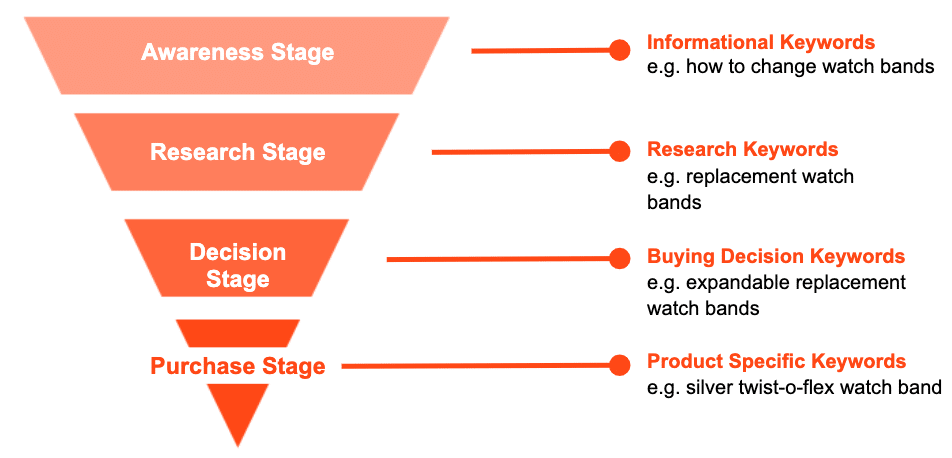For every SEO campaign, success should be defined by sales growth – not merely improvements in rankings or growth in organic traffic.
Unfortunately, many brands pursue SEO strategies that lead to an increase in organic traffic, but no sales. These strategies include content-based SEO approaches like publishing informational articles, product comparisons and FAQs. This type of content can be great for driving traffic, but doesn’t always lead to purchases. Choosing keywords that people use when they’re ready to make a purchase can help you meet both your traffic and sales goals.

Why Am I Getting Traffic, But No Sales?
It’s exciting to finally see your organic traffic numbers increase, especially after working hard to draw those visitors in. But if your visitors aren’t converting into customers, you may need to rethink the content you’re using to get people to click on your site.
Your website’s content may be ranking well on search engines, but for keywords that bring in visitors who are looking for information and aren’t ready to make a purchase. Getting traffic, but no sales can signal a need to go back to square one and do some more targeted keyword research that focuses on the intent behind the terms.
Prioritize Search Intent in Keyword Research
Look beyond search volume and difficulty to research the intent behind your keywords. Search intent answers the question of “Why?” someone is searching for a specific term. Alignment between keyword intent and the products you offer is crucial.
Logically, this makes sense. If a website selling water filters only ranks for tooth brush keywords (e.g. “electric tooth brush” and “kids tooth brushes”), it will experience non-existent sales. This is obvious.
It’s less obvious how subtle differences in keyword intent can make or break conversion rates…
A while back, we analyzed the results of an SEO campaign for a client selling 3d printers. They were generating traffic for two important keywords: “3d printer” and “3d printing”.
Through our analysis, we learned that the “3d printer” keyword converted well and generated e-commerce sales for the brand. The “3d printing” keyword did not convert at all – not one sale.
After a deep dive into the intent behind these keywords, we discovered that people searching for a “3d printer” were interested in buying a 3d printer machine. People who were searching for “3d printing” were looking for a service to do the printing for them.
This means that traffic for the “3d printing” keyword was worthless to our client. They didn’t offer a 3d printing service. They only sold machines.
This subtle (but crucially important) distinction between the intent behind these searches is the difference between generating traffic and generating sales. Don’t overlook keyword intent. When performing keyword research, weigh search intent just as heavily—if not more so—than search volume or competition. This is the key to crafting an SEO campaign that stops your site from getting traffic, but no conversions.
How do you determine search intent when researching keywords?
Try these 4 techniques to research keywords with the right search intent to bring in paying customers.
1. Check Google Ads Keywords
Hard data on keyword conversion rates comes from your Google Ads (a.k.a. AdWords) account. This is a case where your paid Google campaigns can inform your SEO strategy. If you are bidding on the keywords in question, you can track conversions in Google Ads and Google Analytics. Consequently, you’ll have a good idea which keywords convert and the intent behind the searches.
2. See What Google Thinks
Decipher keyword intent by typing the keywords into Google and see what pops up. Google is very good at surfacing the most relevant websites for a query. This means you can trust that Google understands the intent behind most queries and shows searchers what they want.
3. Pay Attention to Your Customers
Qualitatively, I recommend paying close attention to the exact words/phrases your customers use during sales conversations. Did they say they are looking for “custom jewelry” or a “custom jeweler”? What is the difference in the eyes of your customer?
4. Spy on Competitors
Research the keywords your competitors target in their paid Google Ads campaigns and landing pages they use. Reviewing both the keywords and the landing pages will give you an idea what your competitors have learned about converting visitors for their target keywords. You can uncover this data with a paid SEO tool like Ahrefs or KeywordSpy. Basically, you can assume that your competitors are rational. So, they are only bidding on keywords that convert for them (otherwise, they would be running unprofitable Google Ads campaigns). For this assumption to hold true, it is best to focus on your most sophisticated competitors.
5. Ignore Generic Terms
Keep in mind that generic, high traffic keywords likely have many search intents behind them (e.g. “sneakers” or “jewelry”). They just aren’t specific enough that we can say everyone typing them into Google is searching for the same thing — e.g. for the “sneakers” keyword, some searchers are looking for kids shoes and others for adult basketball shoes. This is why generic keywords are hard to convert. They might generate a lot of traffic, but we don’t know exactly what the searchers are looking to buy. Analyzing keywords for search intent is most useful for more specific keywords (e.g. “3d printing service” or “dive watch”).
Stop Getting Traffic, But No Conversions
Prioritizing search intent when creating your website’s content will help you stop seeing increased traffic, but no sales.
Search marketing works best when you offer people exactly what they are searching for on the first page they see. The key to growing sales is to target the right keywords: keywords that convert for you because they align with the products/offers on your website.

